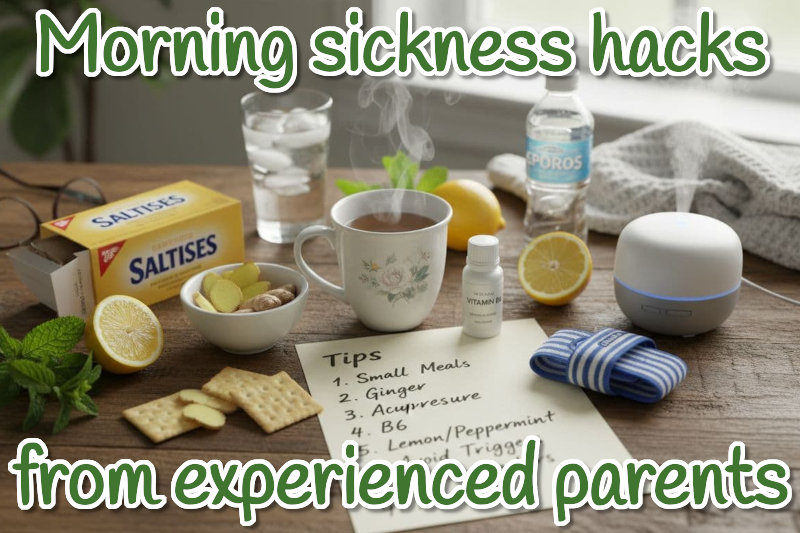Morning Sickness Hacks That Actually Help, From Real Parents in 2025

October 25th, 2025 | Pregnancy
Morning sickness is a misnomer. Nausea can hit at sunrise, lunchtime, or right before bed. It often peaks in the first trimester, then fades as hormones settle. If you’re in the thick of it, you’re not alone. This guide shares morning sickness hacks from real parents who tried everything and kept what worked.
You’ll find simple tweaks you can try today, plus routines that help tomorrow. Since every body is different, track what helps and what does not. Keep what works, skip the rest. If you have nonstop vomiting, signs of dehydration, or weight loss, contact your provider right away. Severe nausea needs medical care, not toughing it out.
Fast-acting morning sickness hacks you can try today
Relief within minutes is the goal. Set up tiny tools you can reach fast. Create a mini kit for your bedside, your bag, and your car. Stock it with salty crackers, ginger or mint lozenges, queasy wrist bands, a small water bottle, and a wet wipe. When a wave builds, you will have your plan ready.
Smart sipping and hydration that stay down
- Try gentle liquids: ice chips, ice-cold water, ginger or mint tea, diluted lemonade, flat ginger ale, or oral rehydration solutions.
- Take tiny sips every few minutes. Big gulps can trigger a gag reflex.
- Add a pinch of salt or an electrolyte powder if your provider approves.
- Keep popsicles in the freezer for a hydrating, easy-to-tolerate option.
- Skip very sweet or very hot drinks if they set off your nausea.
Think of your stomach like a seasick passenger. Slow, steady sips keep the ride smooth.
Snack pairings that calm the stomach
Simple carbs can help, but pairing them with protein keeps nausea from bouncing back.
- Crackers with peanut butter
- Cheese with apple slices
- Yogurt with a bit of granola
- Hummus with pretzels
Gentle starters like salty crackers, dry cereal, rice cakes, or toast help many people. For a quick sugar lift that is not heavy, try citrus segments, frozen grapes, or a banana. Eat small bites every 1 to 2 hours. An empty stomach often makes nausea worse.
Make mornings easier before you get out of bed
Use the bedside snack trick. Keep salty crackers or a small granola bar within reach. Before you sit up, eat a few bites, then wait a minute. Move from lying to sitting to standing in slow steps. Take a few sips of water before you walk to the bathroom. If brushing your teeth is a trigger, try a bland or kids toothpaste, a soft brush, cooler water, and brush after a small snack instead of first thing.
Fresh air, gentle smells, and acupressure
A quick reset can stop a spiral. Open a window, step outside for a minute, or point a small fan toward your face. Some parents find light scents like lemon, peppermint, or lavender soothing. Others cannot tolerate any scent at all. Keep it faint and skip strong perfumes. The P6 acupressure point sits on the inner wrist, about three finger widths below the crease between the two tendons. Wrist bands that press this point help some people. They are low risk and easy to try.
Daily routines that prevent nausea before it starts
Quick fixes help, but routines keep you steadier. Focus on timing, small portions, and avoiding your triggers. Repeat what works until it becomes automatic.
Set your morning routine for fewer waves
Start slow. Dim the lights, take a few breaths, and eat a small bite in bed. Sip water next. If your prenatal vitamin upsets your stomach, try taking it with food or at night. Ask your provider about a different formula if iron is the issue. Vitamin B6 is commonly suggested. Many providers recommend 10 to 25 mg up to three times per day. Some also suggest doxylamine 12.5 mg at night. Only use supplements and medicines with your provider’s guidance.
Eat small, often, and balance protein with carbs
Aim for 5 to 6 mini meals. Keep prep simple so you can eat the moment hunger hits. Big, greasy, spicy, or very sweet meals can backfire if they are your triggers. Choose easy-to-digest proteins like eggs, Greek yogurt, nut butter, tofu, beans, or chicken. Combine them with gentle carbs.
Sample mini-meal day:
| Time | Mini Meal Idea |
|---|---|
| 7:00 a.m. | Crackers in bed, water sips |
| 9:00 a.m. | Yogurt with a few berries |
| 11:30 a.m. | Toast with peanut butter |
| 2:00 p.m. | Apple slices with cheese |
| 4:00 p.m. | Hummus with pretzels |
| 6:30 p.m. | Rice with chicken and steamed carrots |
| 8:30 p.m. | Banana or dry cereal |
Prep a few items on good days. Future you will be grateful.
Manage smells, motion, and toothbrushing triggers
Kitchen tweaks help a lot. Cook with a window open. Use the microwave or air fryer to reduce lingering smells. Prep cold foods, like sandwiches, yogurt bowls, or salads, since they smell less. For motion, sit in the front seat, aim cool air at your face, watch the horizon, and take breaks. For dental care, switch toothpaste flavors, brush later in the morning, or start by rinsing with water. Finding your triggers takes trial and error. Keep notes and adjust.
Work and travel tips that actually help
Pack portable snacks, a leak-proof water bottle, ginger or mint lozenges, and a small bag with wipes. Schedule meetings after a snack window. Build in quick breaks for fresh air or a bathroom reset. A small desk fan can be a life saver on rough days. During commutes, allow extra time, sit near airflow, and carry acupressure wrist bands if motion triggers you. A simple kit can turn a tough day into a manageable one.
What parents wish they knew sooner: products, self care, and when to call the doctor
You do not have to white-knuckle nausea. Small tools, kind routines, and timely medical care can change your day.
Little products that make a big difference
Pregnancy-friendly lozenges or lollipops for nausea, ginger chews, mint drops, and anti-nausea candies can help in short bursts. Many parents like sour lemon or green apple flavors because they cut through queasiness. Keep bland crackers in every bag. Electrolyte powders are useful on dehydrating days. Check labels and ingredients. If you are unsure, ask your provider what is safe for you.
Gentle self care that supports your body and mood
Short naps restore energy. Light stretching, a brief walk, or prenatal yoga can settle your system if your provider approves. Wear loose clothes, keep your space cool, and use a bedside fan. Track your better windows, then plan chores or work during those times. Ask for help with meals, errands, or pet care. This is a season. Taking time off when needed is not a failure. It is smart care.
When nausea is not normal and you need help
Call your provider if you have signs of hyperemesis gravidarum. Red flags include vomiting all day, not keeping fluids down for 24 hours, dark urine, dizziness, dry mouth, fast weight loss, or fainting. Urgent care or the emergency department can give fluids and medications if you cannot keep anything down. You deserve care that helps you eat, drink, and rest.
Safe medications and supplements to discuss with your provider
If lifestyle changes are not enough, there are approved options. Ask about doxylamine-pyridoxine, vitamin B6, certain antihistamines, or other anti-nausea prescriptions. Do not start or combine medicines without medical guidance. Relief is a valid goal. You deserve to feel well enough to function.
Conclusion
Here is the short list to keep in mind. Eat small and often, hydrate with gentle sips, and build a simple routine that avoids your triggers. Try one or two hacks this week, then track what helps. Reach out for care if symptoms are severe or you cannot keep fluids down. Most nausea fades by the second trimester, so hold on to hope and take care of yourself today.
Recent Posts
- Struggling with Chemotherapy Over the Holidays
- Navigating the Holidays with Ease: Managing Travel Sickness While Enjoying the Feasts
- Holiday Travel With Morning Sickness: A Calm Traveler’s Guide
- The Friendly Guide to Keeping Pregnancy Nausea at Bay
- Beat the Morning Sickness Blues: DIY Ginger Remedies for a Calmer Pregnancy
Categories
- All-Natural (4)
- Blog (47)
- Cancer (72)
- Diet (15)
- Holidays (22)
- Lifestyle (67)
- Motion Sickness (44)
- Nausea (102)
- New Mothers (34)
- Oncology Testimonials (3)
- Prebiotics (1)
- Preggie Products (5)
- Preggie Testimonial (23)
- Pregnancy (155)
- Queasy Products (5)
- Queasy Testimonial (17)
